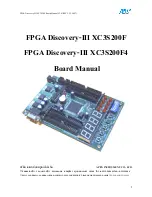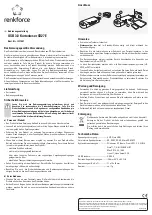
KPCI-3110 and KPCI-3116 User’s Manual
Functional Description
2-7
Internal A/D sample clock
The internal A/D sample clock uses a 20MHz time base. Conversions start on the falling edge of
the counter output; the output pulse is active low.
Using software, specify the clock source as internal and the clock frequency at which to pace the
operation. The minimum frequency supported is 1.2Hz (1.2 Samples/s). For the KPCI-3110
boards, the maximum frequency supported is 1.25MHz (1.25 MSamples/s). For the KPCI-3116
board, the maximum frequency supported is 250kHz (250 kSamples/s).
According to sampling theory (Nyquist Theorem), specify a frequency that is at least twice as
fast as the input’s highest frequency component. For example, to accurately sample a 20kHz sig-
nal, specify a sampling frequency of at least 40kHz. Doing so avoids an error condition called
aliasing
, in which high frequency input components erroneously appear as lower frequencies
after sampling.
NOTE
You can access the output signal from the A/D sample clock using screw
terminal 79 on the STP-3110 screw terminal panel (pin 4 on connector
J2).
External A/D sample clock
The external A/D sample clock is useful when you want to pace acquisitions at rates not avail-
able with the internal A/D sample clock or when you want to pace at uneven intervals.
Connect an external A/D sample clock to screw terminal 76 on the STP-3110 screw terminal
panel (pin 7 on connector J2). Conversions start on the falling edge of the external A/D sample
clock input signal.
Using DriverLINX, specify the clock source as external (refer to
DriverLINX Analog I/O Pro-
gramming Guide
furnished with DriverLINX). For KPCI-3110 and KPCI-3116 boards, the
clock frequency is always equal to the frequency of the external A/D sample clock input signal
that you connect to the board through the screw terminal panel.
Analog input conversion modes
KPCI-3110 and KPCI-3116 boards support the following conversion modes:
•
Single value polled operations
are the simplest to use but offer the least flexibility and effi-
ciency. Use software to specify the range, gain, and analog input channel (among other
parameters); acquire the data from that channel; and convert the result. The data is returned
immediately. For a single value operation, you cannot specify a clock source, trigger source,
trigger acquisition mode, scan mode, or buffer.
Single value operations stop automatically when finished; you cannot stop a single value
operation.
•
Scan mode
takes full advantage of the capabilities of the KPCI-3110 and KPCI-3116
boards. In a scan, you can specify a channel-gain list, clock source, trigger source, trigger
acquisition mode, buffering, and timing. Refer to “Using DriverLINX with Your Hardware:
KPCI-3100 Series” for details on specifying these parameters.
Using DriverLINX software, you can stop a scan when the hardware fills the host buffer you
specified or when your application issues a stop command.
Summary of Contents for KPCI-3110
Page 3: ......
Page 4: ......
Page 7: ......
Page 8: ......
Page 16: ...Preface...
Page 20: ...1 Overview...
Page 25: ...2 Functional Description...
Page 54: ......
Page 55: ......
Page 57: ......
Page 58: ......
Page 59: ......
Page 61: ...3 Installation and Configuration...
Page 66: ......
Page 68: ......
Page 80: ......
Page 81: ......
Page 82: ......
Page 83: ......
Page 84: ......
Page 85: ......
Page 86: ...4 Testing the Board...
Page 89: ...5 Calibration...
Page 92: ...6 Troubleshooting...
Page 99: ...A Specifications...
Page 111: ...B Connector Pin Assignments...
Page 116: ...C Systematic Problem Isolation...
Page 143: ...D Using Your Own Screw Terminal Panel...
Page 156: ......
















































